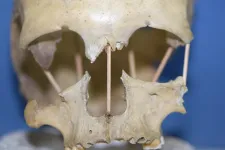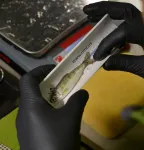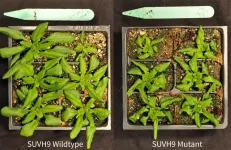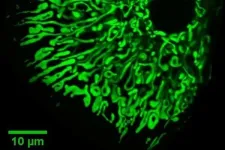(Press-News.org) For the first time, researchers have successfully sequenced the entire genome from the skull of Peştera Muierii 1, a woman who lived in today's Romania 35,000 years ago. Her high genetic diversity shows that the out of Africa migration was not the great bottleneck in human development but rather this occurred during and after the most recent Ice Age. This is the finding of a new study led by Mattias Jakobsson at Uppsala University and being published in Current Biology.
"She is a bit more like modern-day Europeans than the individuals in Europe 5,000 years earlier, but the difference is much less than we had thought. We can see that she is not a direct ancestor of modern Europeans, but she is a predecessor of the hunter-gathers that lived in Europe until the end of the last Ice Age," says Mattias Jakobsson, professor at the Department of Organismal Biology at Uppsala University and the head of the study.
Very few complete genomes older than 30,000 years have been sequenced. Now that the research team can read the entire genome from Peştera Muierii 1 (see the fact box below), they can see similarities with modern humans in Europe while also seeing that she is not a direct ancestor. In previous studies, other researchers observed that the shape of her cranium has similarities with both modern humans and Neanderthals. For this reason, they assumed that she had a greater fraction of Neanderthal ancestry than other contemporaries, making her stand out from the norm. But the genetic analysis in the current study shows that she has the same low level of Neanderthal DNA as most other individuals living in her time. Compared with the remains from some individuals who lived 5,000 years earlier, such as Peştera Oase 1, she had only half as much Neanderthal ancestry.
The spread of modern humans out of Africa about 80,000 years ago is an important period in human history and is often described as a genetic bottleneck. Populations moved out of Africa and into Asia and Europe. The effects of these migrations can be seen even today. Genetic diversity is lower in populations outside of Africa than in African. That Peştera Muierii 1 has high genetic diversity implies that the greatest loss of genetic diversity occurred during the last Ice Age (which ended about 10,000 years ago) instead of during the out of Africa migration.
"This is exciting since it teaches us more about the early population history of Europe. Peştera Muierii 1 has much more genetic diversity than expected for Europe at this time. This shows that genetic variation outside of Africa was considerable until the last Ice Age, and that the Ice Age caused the decrease in diversity in humans outside of Africa."
The researchers were also able to follow the genetic variation in Europe over the last 35,000 years and see a clear decrease in variations during the last Ice Age. The reduced genetic diversity has previously been linked to pathogenic variants in genomes being more common among populations outside of Africa, but this is in dispute.
"Access to advanced medical genomics has allowed us to study these ancient remains and even be able to look for genetic diseases. To our surprise, we did not find any differences during the last 35,000 years, even though some individuals alive during the Ice Age had low genetic diversity.
Now we have accessed everything possible from these remains. Peştera Muierii 1 is important from a cultural history perspective and will certainly remain interesting for researchers within other areas, but from a genetic perspective, all the data is now available."
INFORMATION:
Svensson E. et al. (2021); Genome of Peştera Muierii skull shows high diversity and low mutational load in pre-glacial Europe, Current Biology, May 18 (11 a.m. ET) DOI: 10.1016/j.cub.2021.04.045, https://www.cell.com/current-biology/fulltext/S0960-9822(21)00592-3.
Further information:
Mattias Jakobsson, Professor at the Department of Organismal Biology at Uppsala University, email: mattias.jakobsson@ebc.uu.se, phone: +46-18-471 64 49, mobile: +46-70-167 97 57
Fact box Peştera Muierii
Peştera Muierii 1 is the name given to one of the three individuals whose remains were found in a cave of the same name. Peştera Muierii (roughly translates to women's cave) is the name of a cave system in Baia de Fier in southern Romania. It is best known for the remains of cave bears and for the 1950s discovery of skulls and other skeletal parts from three females that lived about 35,000 to 40,000 years ago.
DURHAM, N.C. - A newly identified group of antibodies that binds to a coating of sugars on the outer shell of HIV is effective in neutralizing the virus and points to a novel vaccine approach that could also potentially be used against SARS-CoV-2 and fungal pathogens, researchers at the Duke Human Vaccine Institute report.
In a study appearing online May 20 in the journal Cell, the researchers describe an immune cell found in both monkeys and humans that produces a unique type of anti-glycan antibody. This newly described antibody has the ability to attach ...
Juvenile salmon migrating to the sea in the Sacramento River face a gauntlet of hazards in an environment drastically modified by humans, especially with respect to historical patterns of stream flow. Many studies have shown that survival rates of juvenile salmon improve as the amount of water flowing downstream increases, but "more is better" is not a useful guideline for agencies managing competing demands for the available water.
Now fisheries scientists have identified key thresholds in the relationship between stream flow and salmon survival that can serve as actionable targets for managing water resources in the Sacramento River. The new analysis, published May 19 in Ecosphere, revealed nonlinear ...
Today, proteins that can be controlled with light are a widely used tool in research to specifically switch certain functions on and off in living organisms. Channelrhodopsins are often used for the technique known as optogenetics: When exposed to light, these proteins open a pore in the cell membrane through which ions can flow in; this is how nerve cells can be activated. A team from the Centre for Protein Diagnostics (PRODI) at Ruhr-Universität Bochum has now used spectroscopy to discover a universal functional mechanism of channelrhodopsins that determines their efficiency as a channel and thus as an optogenetic tool. The researchers led by Professor Klaus ...
Microfluidic technologies have seen great advances over the past few decades in addressing applications such as biochemical analysis, pharmaceutical development, and point-of-care diagnostics. Miniaturization of biochemical operations performed on lab-on-a-chip microfluidic platforms benefit from reduced sample, reagent, and waste volumes, as well as increased parallelization and automation. This allows for more cost-effective operations along with higher throughput and sensitivity for faster and more efficient sample analysis and detection.
Optoelectrowetting (OEW) is a digital optofluidic technology that is based on the principles of light-controlled electrowetting and enables ...
Since our ancestors infected themselves with retroviruses millions of years ago, we have carried elements of these viruses in our genes - known as human endogenous retroviruses, or HERVs for short. These viral elements have lost their ability to replicate and infect during evolution, but are an integral part of our genetic makeup. In fact, humans possess five times more HERVs in non-coding parts than coding genes. So far, strong focus has been devoted to the correlation of HERVs and the onset or progression of diseases. This is why HERV expression has been studied in samples of pathological origin. Although important, these studies ...
Passing down a healthy genome is a critical part of creating viable offspring. But what happens when you have harmful modifications in your genome that you don't want to pass down? Baby plants have evolved a method to wipe the slate clean and reinstall only the modifications that they need to grow and develop. Cold Spring Harbor Laboratory (CSHL) Professor & HHMI Investigator Rob Martienssen and his collaborators, Jean-Sébastien Parent and Institut de Recherche pour le Développement Université de Montpellier scientist Daniel Grimanelli, discovered one of the genes responsible for reinstalling modifications in a baby plant's genome.
A plant's genomic modifications--called epigenetic ...
The study sought to describe and explain gender pay differences in the U.S. Department of Health and Human Services between 2010 and 2018. HHS comprises a quarter of the country's governmental public health workers, with over 80,000 employees.
Understanding what may be driving wage gaps at HHS provides opportunities for employers and legislators to take action to support women in the health care field, said lead author Zhuo "Adam" Chen, an associate professor of health policy and management at UGA's College of Public Health.
"A large percentage of the health care workforce are women," said Chen. "If you have underpaid women in the profession, I don't think it spells good things for the public health system."
Chen ...
Maywood, Ill. - May 19, 2021 - A team of scientists from Loyola University Chicago's Stritch School of Medicine have discovered a critical component for renewing the heart's molecular motor, which breaks down in heart failure.
Approximately 6.2 million Americans have heart failure, an often fatal condition characterized by the heart's inability to pump enough blood and oxygen throughout the body. This discovery could represent a novel approach to repair the heart.
Their findings, published in the May 19 issue of Nature Communications, show how a protein called BAG3 helps replace "worn-out" components of the cardiac sarcomere. The sarcomere is a microscopic ...
FINDINGS
A new multi-institution study led by a team of researchers at the David Geffen School of Medicine demonstrated that blocking a protein called ABCB10 in liver cells protects against high blood sugar and fatty liver disease in obese mice. Furthermore, ABCB10 activity prompted insulin resistance in human liver cells.
The findings are the first to show that ABCB10 transports biliverdin out of the mitochondria - the cell's "energy generating powerhouses." Biliverdin is the precursor of bilirubin, a substance with antioxidant properties. Consequently, ABCB10 transport ...
So, you thought the problem of false information on social media could not be any worse? Allow us to respectfully offer evidence to the contrary.
Not only is misinformation increasing online, but attempting to correct it politely on Twitter can have negative consequences, leading to even less-accurate tweets and more toxicity from the people being corrected, according to a new study co-authored by a group of MIT scholars.
The study was centered around a Twitter field experiment in which a research team offered polite corrections, complete with ...






